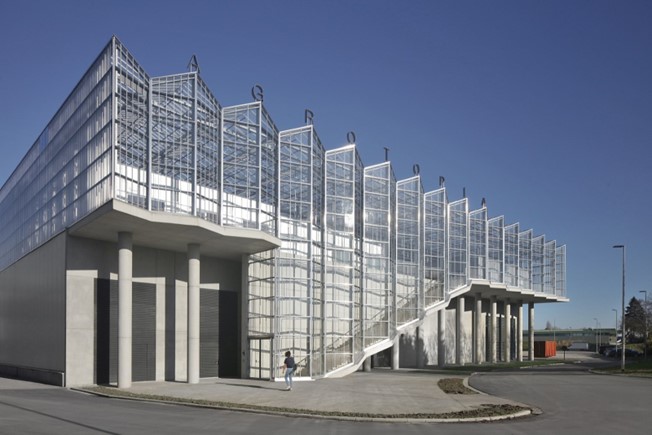Inagro in Roeselare, Belgium, is a research and advice centre in agriculture and horticulture. It has two pilot setups to research and demonstrate renewable energy sources for greenhouses. The first pilot is at Agrotopia, the biggest rooftop greenhouse of Europe, connected to residual heat and a heat network. The second pilot is the biogas installation at the main site of Inagro.
Pilot 1: Agrotopia, an innovative rooftop greenhouse
Agrotopia is built on the roof of the REO Veiling, an auction for more than 70 types of fresh fruit and vegetables. With 6000 square meters of cultivation area, divided into thirteen compartments- there is ample space in Agrotopia to develop, test, and demonstrate new technologies for leafy vegetables and fruit vegetables such as tomatoes and cucumbers. Furthermore, Agrotopia is equipped with an indoor vertical farm which serves as a research instrument to quickly test and screen new innovations in a highly controlled environment. At Agrotopia, they only grow hydroponics. For leafy vegetables there are both DFT and NFT systems which are comparable to practical situations with farmers. For the cultivation of fruit vegetables, they use high wire systems combined with substrate mats.
For heating, Agrotopia relies on two external energy sources:
- the Combined Heat and Power (CHP) plant of REO Veiling
- and the district heating network of MIROM.
The nearby waste processing company MIROM offers its residual heat to the city of Roeselare via underground hot water pipes. The rooftop greenhouse can partially utilize the released heat from the CHP plant of REO Veiling, located next to the warehouse, to heat the greenhouse. This CHP is used for the refrigeration of their produce. By using this excess heat, they do not emit any fossil fuels to grow crops in Agrotopia.

Pilot 2: biogas installation
At the main site of Inagro there is a small-scale plug-and-play biogas installation. It’s a classical Continuously Stirred Tank Reactor (CSTR) with a total volume of 200 m³ and a nominal volume of 150 m³. This installation can be operated at mesophilic (± 40°C) or thermophilic (± 50-60°C) temperatures. The installation is equipped with a Combined Heat and Power (CHP) unit of 31 kWel, where the biogas is producing renewable energy in the form of electricity and heat. Prior to burning the biogas in the CHP unit, water vapour and sulphur are removed from the biogas by a condensation step and biological desulphurization, respectively. This is the standard way of how a farm scale AD plant is being operated.
The reactor can be fed with liquid or solid agroresidues. Liquid agroresidues are being stored in two silage tanks and being pumped into the reactor. Solid agroresidues are being fed to the reactor via a Trioliet screw press (see image). Up to today (beginning of 2024), the feed fully consists of crop residues such as chicory roots and leaves, maize silage, rotten potatoes, grass. Production of heat and electricity can be scheduled to cover the main consumption peaks. Ongoing research focuses on upgrading the biogas to a higher methane content so it can be compressed for storage and to cover longer periods with a high power consumption.
Data gathering for the RES decision tool
Agrotopia has an important role to help develop the RE-Greenhouse RES decision tool. By gathering data during the cultivation of the crop, Inagro will provide partner Ifas the necessary dataset to develop the decision tool. Inagro will not only log the heat usage in different greenhouse compartments (leafy vegetables and fruit vegetables), they will also monitor environmental parameters.
In the biogas pilot we will analyze the biogas potential of different greenhouse waste streams. The biogas potential in combination with the available mass will give us a clear indication of the potential heat and electricity production levels.
Demonstration and co-creation
The pilots of Inagro will demonstrate the potential of non-fossil energy sources to grow crops in a greenhouse.
At Agrotopia we will invite and engage with different stakeholders from the Agro-Business Complex to educate them on the benefits of using non-fossil heat sources to help make the greenhouse sector more sustainable. In addition, we will gather input from this group of stakeholders to better understand their needs. This allows us to develop a tool that will be more readily taken up by the sector.
The biogas pilot consists of a farm-scale plug-and-play biogas installation, suitable for on-farm renewable energy production by valorizing agroresidues. The biogas plant will monitor a number of parameters such as gas production levels, biogas composition and produced heat and electricity levels.
Fact sheet
View the fact sheets on the Inagro pilots:
More info
- Agrotopia: Maarten Ameye - maarten.ameye@inagro.be
- Biogas: Pieter Vercruysse – pieter.vercruysse@inagro.be